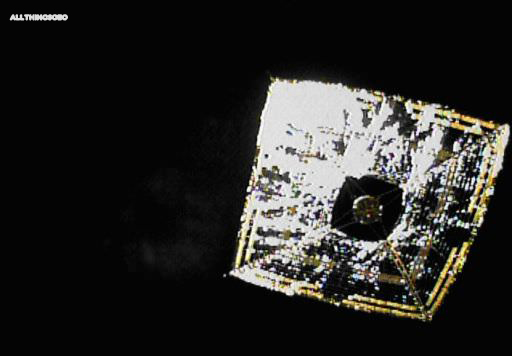NASA Successfully Launches and Activates New Solar Sail
Key Takeaway
NASA’s Advanced Composite Solar Sail System, a CubeSat designed to test a new lightweight and stiff composite sail support structure, has successfully launched and deployed its 9-meter solar sail in low-Earth orbit, marking a significant milestone in the development of efficient solar sail propulsion technology.
Summary
- NASA’s Advanced Composite Solar Sail System was launched aboard a RocketLab Electron rocket on Tuesday, April 23, 2024.
- The CubeSat aims to test the deployment of large solar sails in low-Earth orbit, using a new composite boom support structure made from flexible polymer and carbon fiber materials.
- On Wednesday, April 24, 2024, NASA confirmed the successful deployment of a 9-meter (80 square meters) solar sail from the CubeSat in low-Earth orbit.
- Solar sails harness the pressure of sunlight to propel spacecraft, offering an efficient propulsion system without the need for heavy engines or fuel tanks.
- The concept of solar sails dates back to the 17th century, when Johannes Kepler suggested using sunlight to push spacecraft, but the first practical solar sail vehicle was IKAROS, launched in 2010.
- The new composite boom support structure developed by NASA is designed to be stiffer and lighter than existing support structure designs, enabling larger sail sizes.
- The deployment process took about 25 minutes, and if conditions are favorable, the deployed sail may be visible from Earth, potentially rivaling the brightness of Sirius.
- This successful deployment is a significant milestone in the development of efficient solar sail propulsion technology for future space exploration missions.

NASA’s Groundbreaking Solar Sail Deployment
In the vastness of space, where conventional propulsion systems face limitations, solar sails offer a promising alternative for propelling spacecraft across the cosmic expanse. NASA’s recent achievement in deploying a 9-meter solar sail from its Advanced Composite Solar Sail System (ACS3) has ignited excitement among space enthusiasts and researchers alike.
Solar sails, much like the maritime sails of old, harness the power of light to navigate through the celestial seas. These enigmatic structures rely on the momentum transfer from photons striking their reflective surfaces, generating a gentle yet continuous thrust. This propulsion method eliminates the need for heavy engines and fuel tanks, making solar sails an incredibly efficient and sustainable solution for space travel.
While the concept of solar sails dates back to the 17th century, when Johannes Kepler first envisioned using sunlight to propel spacecraft, it wasn’t until the 20th century that scientists like Konstantin Tsiolkovsky and Carl Sagan brought this idea closer to reality. However, it took until 2010 for the first practical solar sail vehicle, IKAROS, to be launched by the Japan Aerospace Exploration Agency (JAXA).
On April 23, 2024, NASA’s ACS3 CubeSat hitched a ride aboard a RocketLab Electron rocket, embarking on a mission to test the deployment of large solar sails in low-Earth orbit. Developed in collaboration with NanoAvionics, the ACS3 features a revolutionary composite boom support structure made from flexible polymer and carbon fiber materials.
This innovative design aims to address one of the biggest challenges in solar sail technology: creating a support structure that is both lightweight and stiff enough to support larger sail sizes. By successfully deploying a 9-meter (80 square meters) sail on April 24, 2024, NASA has demonstrated the potential of this new composite boom technology to enable larger and more efficient solar sails.
The deployment process itself was a marvel of engineering precision. Over the course of 25 minutes, the ACS3 CubeSat meticulously unfurled its solar sail, stretching it to its full 9-meter span. NASA’s confirmation of the successful deployment marked a momentous occasion, as the sail’s vast expanse now reflects the sun’s rays, generating the propulsive force that could propel future spacecraft across the cosmic frontier.
If conditions are favorable, the deployed sail may even become visible from Earth, potentially rivaling the brightness of Sirius, the brightest star in our night sky. This celestial spectacle serves as a reminder of humanity’s ongoing quest to explore the unknown and push the boundaries of space exploration.
The successful deployment of NASA’s ACS3 solar sail is more than just a technological achievement; it represents a significant step towards unlocking the full potential of solar sail propulsion. With larger and more efficient sails, future space missions could venture deeper into the solar system and beyond, reaching destinations previously deemed impractical or impossible with conventional propulsion systems.

Moreover, solar sails could play a crucial role in facilitating sustainable space exploration by reducing our reliance on finite resources and minimizing the environmental impact of space missions. As we continue to explore the cosmos, the development of innovative propulsion technologies like solar sails will be instrumental in shaping our journey among the stars.
As NASA and other space agencies continue to refine and expand solar sail technology, we can expect to witness even more remarkable feats in the years to come. Each deployment, each successful mission, brings us closer to a future where solar sails become an integral part of our endeavors in space exploration, propelling humanity towards new frontiers and unlocking the secrets of the universe.
HASHTAGS:
#NASAsolarsail, #spacetechnology, #solarsailpropulsion, #spaceexploration, #sustainablespaceflight, #cubesatmission, #lowEarthorbit, #compositebooms, #photonpropulsion, #futuristicpropulsion #New Solar Sail
Source:
- NASA Blogs: Solar Sail CubeSat Has Deployed: Read about the deployment of a solar sail CubeSat, highlighting advancements in small satellite technology and solar sail propulsion.

